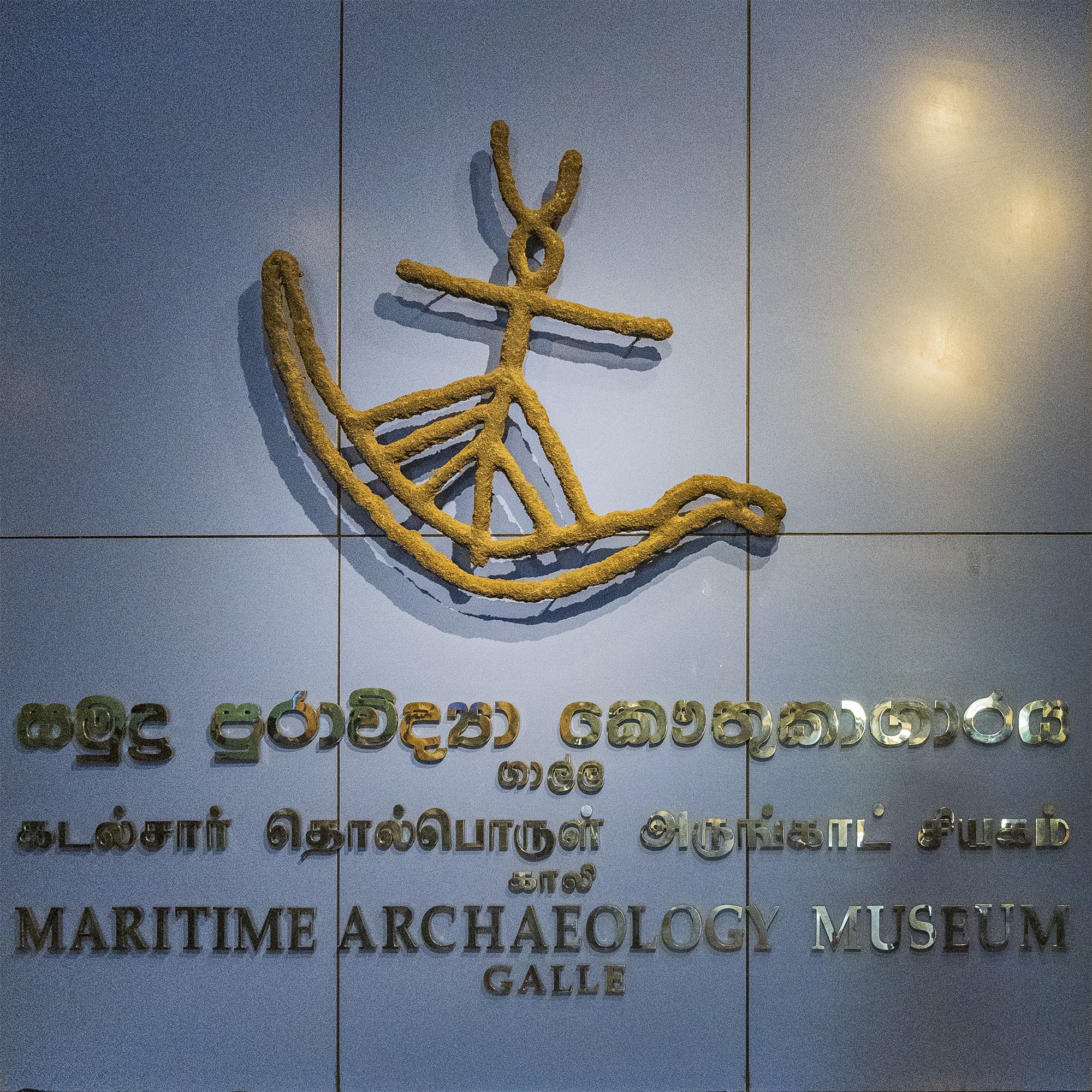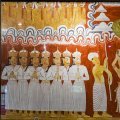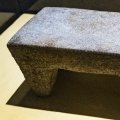Maritime Museum (Galle): photo 4
Photo 4 of 63 in Gallery: Maritime Museum (Galle)

Image title: The Logo of the Maritime Museum
Description of the photo
English text:
The logo of the Maritime Archaeology Museum depicts a vessel with a single mast, which is an iconic representation engraved on a 2nd or 1st Century BC Brahmi cave inscription at Duvegala ir the Polonnaruva District. The inscription reads, "cave of Sagrakita, the barata". The symbol itself comprises of two components. The helm of the mast is adorned with the nandipada or taurine which is a popular auspicious symbol associated with early historic sculpture and coins. The ship with the single or double mast represents the type of vessels that traversed the sea lanes connecting Sri Lanka with the delta of the Ganges River. Such symbols are found on the Satavahana bi-lingual coins and as post firing graffiti from several Early Historic coastal sites extending all the way from ancient Mahagama of South Sri Lanka to Kalinga and Tampralipti in east India.
The term Barata (and Bata) recorded in the pre Christian inscriptions of Sri Lanka, also known to the Sangam texts of South India as Paratavar, are identified with the seafaring community wha exploited marine resources in the littoral of south India. During the early Historic period they developed an affluent merchant group who carried out a thriving luxury trade between Sri Lanka and South India and are also known to be intermediaries connecting Sri Lanka with the Mediterranean trade. Inscriptions record that certain members of the Barata entered the Order of monks and became specialists in the doctrinal aspects of Buddhism.
The ship essentially symbolizes the self identity of Asian communities who engaged themselves in long distance sailing as an inherent cultural characteristic and economic endeavor. The ship with the single mast therefore is the most appropriate logo for the Maritime Archaeology Museum as it unfolds the rich experience of trans-oceanic connectivity having a long antiquity and enriched the multi cultural ethos of Sri Lanka.
Sinhala text (not proofread):
මුහුදු පුරාවිද්යා කෞතුකාගාරයේ ලාංඡනය මඟින් පිළිබිඹු කරන්නේ තනි කුහි ගසසින් යුත් නැඩකි. එය පොළොන්නරුව දිස්ත්රික්කයේ පිහිටි දුවේසල නම් ස්ථානයේ වූ ක්රිස්තු පූර්ව පළමුවන හෝ දෙවන සියවසට අයත් බ්රාක්ෂි සෙල්ලිපියක දැක්වෙන්නකි. සෙල්ලිපියේ කොටා තිබෙන්නේ බරස වංගික සංසරණ්ඩිකගේ ශුභව යන වැසියයි, මෙම ලාංඡකයට කොටස් දෙකක් අන්තර්ගතය කුඩයසේ මුදුනේ දක්වා තිබෙන නන්දිපාද සහ රවුරින් යන සංකේත මුල් ඓසිහාසික යුගයේ මූර්තිකර්ම සහ කාසිවල යොදා තිබෙන කය කවක ජනප්රිය සංකේත දෙකකි. තුඹගස් දෙකක් යොදා සිබෙන නැව් ශ්රී ලංකාවක් නිතයක් අතර මුහුදු මාර්ගවල යාත්රා කර තිබේ. මෙවැනි සංකේත සාතවාහක ද්විභාෂික කාසිවල සහ ශ්රී ලංකාවේ දකුණු පළාතේ පිහිටි සාගම සිට නැගෙනහිර ඉන්දියාවේ කාලිංග සහ කාමුලිප්ති දක්වා වූ වෙරළාසන්න මුඓසිහාසික යුගයට අයත් පුරාවිද්යා ස්ථානවලින් සොයා ගෙන සිමෙක පශ්චාත් දහක කුරුටු සංකේත අතරද දක්නට සිබේ.
ක්රිස්තු පූර්ව යුගයට අයත් ශ්රී ලංකාවේ සෙල්ලිපිවල සඳහන් වන කරන (සහ බස) යන පදය දකුණු ඉන්දීය රචනාවල පරසවර් යනුවෙන් දක්නට ලැබේ. මොවුන් දකුණු ඉන්දියාවේ මුහුද ආශ්රි ප්රදේශවල මුහුදු සම්පත් සමුද්ධරණය කළ පිරිසක් ලෙස හඳුනා ගෙන තිබේ. මුල් ඓසිහාසික යුගයේදී මෙම පිරිස් සුඛෝපභෝගී භාණ්ඩ ශ්රී ලංකාවත් ඉන්දියාවක් අතර වෙළඳාම් කරන බලවත් වෙළඳ කණ්ඩායම් ලෙසක් ශ්රී ලංකාවක් මධ්යධරණි ප්රදේශයක් අතර වෙළඳ කටයුතුවල අතරමැදියන් ලෙසත් වර්ධනය (විය. සෙල්ලිපිවල සඳහන් වන අන්දමට බරතවරු අතරින් ඇතැමෙක් බුද්ධ සාසනයට ඇතුලක් වී එහි දාර්ශනික කරුණු පිළිබඳ විශේෂඥතාවක් ලැබීය. මෙම සංකේතය මඟින් අනන්ය සංස්කෘතික ලක්ෂණයක් ලෙස ආර්ථික කටයුතු වල යෙදුනු දුරස්ත වෙළඳාමේ නිරක ආසියානු ජනතාවකගේ ස්ව අකන්යතාව පිලිබිඹු කරයි. තනි කුඹ ගස සහිත නැව මුහුදු පුරාවිදහා කෞතුකාගාරය නිරූපනය කිරීමට යෝග්යතම ලාංඡනය ලෙස සැලකිය හැක්කේ එවකින් ශ්රී ලංකාව සතු අඛණ්ඩ සහ පෙහොසත් දීර්ඝකාලීන ඔහු සංස්කෘතික අන්තර් - සාමුද්රික සබඳතා පෙන්නුම් කිරිම නිසාය.
Transcription:
muhudu purāvidyā kautukāgārayē lāṅchhanaya maṅgin piḷibiḅu karannē tani kuhi gasasin yut næḍaki. eya poḷonnaruva distrikkayē pihiṭi duvēsala nam sthānayē vū kristu pūrva paḷamuvana hō devana siyavasaṭa ayat brākṣi sellipiyaka dækvennaki. sellipiyē koṭā tibennē barasa vaṅgika saṅsaraṇḍikagē śubhava yana væsiyayi, mema lāṅchhakayaṭa koṭas dekak antargataya kuḍayasē mudunē dakvā tibena nandipāda saha ravurin yana saṅkēta mul aisihāsika yugayē mūrtikarma saha kāsivala yodā tibena kaya kavaka janapriya saṅkēta dekaki. tuḅagas dekak yodā sibena næv śrī laṅkāvak nitayak atara muhudu mārgavala yātrā kara tibē. mevæni saṅkēta sātavāhaka dvibhāṣika kāsivala saha śrī laṅkāvē dakuṇu paḷātē pihiṭi sāgama siṭa nægenahira indiyāvē kāliṅga saha kāmulipti dakvā vū veraḷāsanna muaisihāsika yugayaṭa ayat purāvidyā sthānavalin soyā gena simeka paśchāt dahaka kuruṭu saṅkēta atarada daknaṭa sibē.
kristu pūrva yugayaṭa ayat śrī laṅkāvē sellipivala sandahan vana karana (saha basa) yana padaya dakuṇu indīya rachanāvala parasavar yanuven daknaṭa læbē. movun dakuṇu indiyāvē muhuda āśri pradēśavala muhudu sampat samuddharaṇaya kaḷa pirisak lesa handunā gena tibē. mul aisihāsika yugayēdī mema piris sukhōpabhōgī bhāṇḍa śrī laṅkāvat indiyāvak atara veḷandām karana balavat veḷanda kaṇḍāyam lesak śrī laṅkāvak madhyadharaṇi pradēśayak atara veḷanda kaṭayutuvala ataramædiyan lesat vardhanaya (viya. sellipivala sandahan vana andamaṭa baratavaru atarin ætæmek buddha sāsanayaṭa ætulak vī ehi dārśanika karuṇu piḷibanda viśēṣagnatāvak læbīya. mema saṅkētaya maṅgin ananya saṅskrutika lakṣaṇayak lesa ārthika kaṭayutu vala yedunu durasta veḷandāmē niraka āsiyānu janatāvakagē sva akanyatāva pilibiḅu karayi. tani kuḅa gasa sahita næva muhudu purāvidahā kautukāgāraya nirūpanaya kirīmaṭa yōgyatama lāṅchhanaya lesa sælakiya hækkē evakin śrī laṅkāva satu akhaṇḍa saha pehosat dīrghakālīna ohu saṅskrutika antar - sāmudrika sabandatā pennum kirima nisāya.
Transcription:
muhudu puravidya kautukagaraye lanchhanaya mangin pilibiḅu karanne tani kuhi gasasin yut nadaki. eya polonnaruva distrikkaye pihiti duvesala nam sthanaye vu kristu purva palamuvana ho devana siyavasata ayat brakshi sellipiyaka dakvennaki. sellipiye kota tibenne barasa vangika sansarandikage shubhava yana vasiyayi, mema lanchhakayata kotas dekak antargataya kudayase mudune dakva tibena nandipada saha ravurin yana sanketa mul aisihasika yugaye murtikarma saha kasivala yoda tibena kaya kavaka janapriya sanketa dekaki. tuḅagas dekak yoda sibena nav shri lankavak nitayak atara muhudu margavala yatra kara tibe. mevani sanketa satavahaka dvibhashika kasivala saha shri lankave dakunu palate pihiti sagama sita nagenahira indiyave kalinga saha kamulipti dakva vu veralasanna muaisihasika yugayata ayat puravidya sthanavalin soya gena simeka pashchat dahaka kurutu sanketa atarada daknata sibe.
kristu purva yugayata ayat shri lankave sellipivala sandahan vana karana (saha basa) yana padaya dakunu indiya rachanavala parasavar yanuven daknata labe. movun dakunu indiyave muhuda ashri pradeshavala muhudu sampat samuddharanaya kala pirisak lesa handuna gena tibe. mul aisihasika yugayedi mema piris sukhopabhogi bhanda shri lankavat indiyavak atara velandam karana balavat velanda kandayam lesak shri lankavak madhyadharani pradeshayak atara velanda katayutuvala ataramadiyan lesat vardhanaya (viya. sellipivala sandahan vana andamata baratavaru atarin atamek buddha sasanayata atulak vi ehi darshanika karunu pilibanda visheshagnatavak labiya. mema sanketaya mangin ananya sanskrutika lakshanayak lesa arthika katayutu vala yedunu durasta velandame niraka asiyanu janatavakage sva akanyatava pilibiḅu karayi. tani kuḅa gasa sahita nava muhudu puravidaha kautukagaraya nirupanaya kirimata yogyatama lanchhanaya lesa salakiya hakke evakin shri lankava satu akhanda saha pehosat dirghakalina ohu sanskrutika antar - samudrika sabandata pennum kirima nisaya.
Automated translation (not verified):
The logo of the Museum of Maritime Archeology depicts a ship with a single hollow tree. It is a reference to a Brakshi inscription belonging to the first or second century BC at a place called Duvesala in Polonnaruwa district. The inscription is inscribed with the patron saint of Barasa Wangika Sansarandika, the emblem consists of two parts, the symbols of Nandipada and Raurin at the top of the umbrella are two popular body symbols used in early prehistoric sculptures and coins. Ships powered by two masts have regularly sailed the seas between Sri Lanka. Symbols like this are found on Satavahaka bilingual coins and Simeka post-Dahaka script symbols found in coastal prehistoric sites from Sagama in the southern province of Sri Lanka to Kalinga and Kamulipti in eastern India. The term karana (and basa) mentioned in Sri Lankan inscriptions of the pre-Christian period is found in South Indian compositions as Parasavara. They have been identified as a group that imported marine resources from the coastal areas of South India. In the early historical period, these people developed into powerful trade groups trading luxury goods between Sri Lanka and India, and as middlemen in trade between Sri Lanka and the Mediterranean region. According to inscriptions, some of the Bharatas entered the Buddha Sasana and became experts in its philosophical matters. As a unique cultural feature, it reflects the indifference of an Asian people engaged in long-distance trade. The single-masted ship can be considered as the most suitable symbol to represent Sri Lanka's continuous and rich inter-cultural maritime relations. because
Tamil text (not proofread):
கடற்சார் தொல்பொருள் அருங்காட்சியகத்தின் அடையாளமாக தனி பாய்மரம் கொண்ட ஒரு கப்பல் காணப்படும். அது பொலனருவையில் தூவேகல என்றிடத்திலுள்ள கிறிஸ்துவிற்கு முன் இரண்டாம் அல்லது முதலாம் நூற்றாண்டை சேர்ந்த ஒரு பிராக்மி குகை கல்வெட்டில் வெட்டிருக்கும் ஒரு சின்னத்தில் மாதிரியாகும். கல்வெட்டில் "பரத வம்சத்துச் சங்கரக்கிதருடைய குகை" எனச் சொல்லிருக்கிறது. இந்த அடையாளத்தில் இரு பாகங்கள் உள்ளன. பாய்மரத்தின் மேல் பாகத்தில் காணக்கூடிய நந்திபாத மற்றும் ரவுரின் என்னும் இரு சின்னங்கள், முதல் வரலாற்று யுகத்தில் செய்யப்பட்ட காக மற்றும் மூர்த்திகளில் செல்வத்தை எடுத்துக்காட்டும் வகையில் சனரஞ்சகமாய் பாவிக்கப்பட் இரண்டு இலட்சுமிகரமான சின்னங்களே. இரண்டு பாய்மரங்கள் உள்ள கப்பல்கள் இலங்கையும் கங்கை நதிக்கரையும் இடையில் உள்ள கடற் பாதைகளில் யாத்திரை செய்துள்ளன. இவ்வாரான சின்னங்கள் சாதவாகள் இரு மொழி காசுகளிலும் இந்திய காலிங்க மற்றும் தாம்ரலிப்தி வரையிலான கடலருகிலுள்ள முதல் வரலாற்று யுகத்தைச் சேர்ந்த இடங்களிலிருந்து கண்டுபிடித்துள்ள கட்டப்பின் எழுதப்படும் கிராப்பிாரி முறையில் செய்துள்ள சின்னங்களிலும் காணக்கூடியதாகும். இலங்கையில் கிறிஸ்துவிற்கு முதல் பாகத்தில் எழுதப்பட்ட கல்வெட்டுகளில் காணப்படும் பரத (மற்றும் பத) என்னும் வார்த்தையை தென் இந்திய குறிப்புகளில் பரதவர் என்று கூறப்பட்டுள்ளது. இவர்கள் தென் இந்தியாவில் சமுத்திரத்தைச் சேர்ந்த பிரதேசங்களில் பரவலாக உள்ள பொருட்களை பாவனைக்கு எடுத்த ஒரு சமுதாயமென அறிமுகப்பட்டோராகும். வரலாற்றின் முதல் பாகத்தில் இவர்கள்
இந்த அடையாளத்தால், தனக்குரிய விசேடமான கலாசார இலட்சனமாகவும் வர்த்தகத்தின் உள்ள உற்சாகத்தைக் காட்டும் சின்ளமாகவும், தூரத்து கடற்பயணங்களில் ஈடுபடுதலுடன் வர்த்தகம் செய்த ஆசியாவில் வசித்து வந்த சமுதாயங்களில் சுய அடையாளத்தை எடுத்துக் காட்டும், ஆகையால், சமுத்திரங்களிடையில் நீண்ட காலமாய் இலங்கையால் அனுபவித்து வந்த பலவித கலாசார உரவுகளால் கைக்கிட்டிய பாரிய அனுபவங்களை எடுத்துக் காட்டும் கடற்சார் தொல்பொருள் அருங்காட்சியகத்திற்காக மிகவும் பொருத்தமான அடையாளம், இந்த தனி பாய்மரத்துடன் நிற்கும் கப்பலேயாகும்.
Transcription:
kaṭaṟcār tolporuḷ aruṅkāṭciyakattiṉ aṭaiyāḷamāka taṉi pāymaram koṇṭa oru kappal kāṇappaṭum. atu polaṉaruvaiyil tūvēkala eṉṟiṭattiluḷḷa kiṟistuviṟku muṉ iraṇṭām allatu mutalām nūṟṟāṇṭai cērnta oru pirākmi kukai kalveṭṭil veṭṭirukkum oru ciṉṉattil mātiriyākum. kalveṭṭil "parata vamcattuc caṅkarakkitaruṭaiya kukai" eṉac collirukkiṟatu. inta aṭaiyāḷattil iru pākaṅkaḷ uḷḷaṉa. pāymarattiṉ mēl pākattil kāṇakkūṭiya nantipāta maṟṟum ravuriṉ eṉṉum iru ciṉṉaṅkaḷ, mutal varalāṟṟu yukattil ceyyappaṭṭa kāka maṟṟum mūrttikaḷil celvattai eṭuttukkāṭṭum vakaiyil caṉarañcakamāy pāvikkappaṭ iraṇṭu ilaṭcumikaramāṉa ciṉṉaṅkaḷē. iraṇṭu pāymaraṅkaḷ uḷḷa kappalkaḷ ilaṅkaiyum kaṅkai natikkaraiyum iṭaiyil uḷḷa kaṭaṟ pātaikaḷil yāttirai ceytuḷḷaṉa. ivvārāṉa ciṉṉaṅkaḷ cātavākaḷ iru moḻi kācukaḷilum intiya kāliṅka maṟṟum tāmralipti varaiyilāṉa kaṭalarukiluḷḷa mutal varalāṟṟu yukattaic cērnta iṭaṅkaḷiliruntu kaṇṭupiṭittuḷḷa kaṭṭappiṉ eḻutappaṭum kirāppiāri muṟaiyil ceytuḷḷa ciṉṉaṅkaḷilum kāṇakkūṭiyatākum. ilaṅkaiyil kiṟistuviṟku mutal pākattil eḻutappaṭṭa kalveṭṭukaḷil kāṇappaṭum parata (maṟṟum pata) eṉṉum vārttaiyai teṉ intiya kuṟippukaḷil paratavar eṉṟu kūṟappaṭṭuḷḷatu. ivarkaḷ teṉ intiyāvil camuttirattaic cērnta piratēcaṅkaḷil paravalāka uḷḷa poruṭkaḷai pāvaṉaikku eṭutta oru camutāyameṉa aṟimukappaṭṭōrākum. varalāṟṟiṉ mutal pākattil ivarkaḷ
inta aṭaiyāḷattāl, taṉakkuriya vicēṭamāṉa kalācāra ilaṭcaṉamākavum varttakattiṉ uḷḷa uṟcākattaik kāṭṭum ciṉḷamākavum, tūrattu kaṭaṟpayaṇaṅkaḷil īṭupaṭutaluṭaṉ varttakam ceyta āciyāvil vacittu vanta camutāyaṅkaḷil cuya aṭaiyāḷattai eṭuttuk kāṭṭum, ākaiyāl, camuttiraṅkaḷiṭaiyil nīṇṭa kālamāy ilaṅkaiyāl aṉupavittu vanta palavita kalācāra uravukaḷāl kaikkiṭṭiya pāriya aṉupavaṅkaḷai eṭuttuk kāṭṭum kaṭaṟcār tolporuḷ aruṅkāṭciyakattiṟkāka mikavum poruttamāṉa aṭaiyāḷam, inta taṉi pāymarattuṭaṉ niṟkum kappalēyākum.
Transcription:
kadarsar tholporul arungadsiyagathin adaiyalamaga thani paymaram konda oru kappal kanappadum. athu polanaruvaiyil thuvegala enridathilulla kiristhuvirku mun irandam allathu muthalam nurrandai serntha oru piragmi kugai kalvettil vettirukkum oru sinnathil mathiriyagum. kalvettil "paratha vamsathus sangarakkitharudaiya kugai" enas sollirukkirathu. intha adaiyalathil iru pagangal ullana. paymarathin mel pagathil kanakkudiya nanthipatha marrum ravurin ennum iru sinnangal, muthal varalarru yugathil seyyappatta kaga marrum murthigalil selvathai eduthukkattum vagaiyil sanaranchagamay pavikkappad irandu iladsumigaramana sinnangale. irandu paymarangal ulla kappalkal ilangaiyum kangai nathikkaraiyum idaiyil ulla kadar pathaigalil yathirai seythullana. ivvarana sinnangal sathavagal iru mozhi kasugalilum inthiya kalinga marrum thamralipthi varaiyilana kadalarugilulla muthal varalarru yugathais serntha idangalilirunthu kandupidithulla kattappin ezhuthappadum kirappiari muraiyil seythulla sinnangalilum kanakkudiyathagum. ilangaiyil kiristhuvirku muthal pagathil ezhuthappatta kalvettugalil kanappadum paratha (marrum patha) ennum varthaiyai then inthiya kurippugalil parathavar enru kurappattullathu. ivarkal then inthiyavil samuthirathais serntha pirathesangalil paravalaga ulla porudkalai pavanaikku edutha oru samuthayamena arimugappattoragum. varalarrin muthal pagathil ivarkal
intha adaiyalathal, thanakkuriya visedamana kalasara iladsanamagavum varthagathin ulla ursagathaig kattum sinlamagavum, thurathu kadarpayanangalil idupaduthaludan varthagam seytha asiyavil vasithu vantha samuthayangalil suya adaiyalathai eduthug kattum, agaiyal, samuthirangalidaiyil ninda kalamay ilangaiyal anupavithu vantha palavitha kalasara uravugalal kaikkittiya pariya anupavangalai eduthug kattum kadarsar tholporul arungadsiyagathirkaga migavum poruthamana adaiyalam, intha thani paymarathudan nirkum kappaleyagum.
Automated translation (not verified):
A ship with a single sail can be seen as a symbol of the Maritime Archeology Museum. It is modeled on a symbol carved in a Brahmi cave inscription of the second or first century BC at Duvegala in Polanaru. The inscription says "the cave of Shankarakitha of the Bharata Dynasty". This sign has two parts. The two symbols of Nandipada and Raurin seen on the upper part of the sail are the two lakhs of symbols that were lavishly used to represent wealth in the crow and murtis made in the first historical age. Ships with two sails plied the sea lanes between Sri Lanka and the banks of the Ganges. Such symbols can be found on the Satavas' bilingual coins and the inscriptions made in the form of script written by Kattava from coastal prehistoric sites as far away as Kalinga and Tamralipti in India. The word Bharata (and Pada) found in inscriptions written in the first part of Christ in Ceylon is referred to as Bharatava in South Indian references. They were introduced as a community in South India who used the products widely available in the maritime regions. They were in the first part of history. With this symbol, it is a unique cultural ideal and a symbol of the spirit of trade, a symbol of self-identity among societies living in Asia who engaged in long-distance voyages and trade, and therefore a very suitable symbol for the Maritime Archeology Museum, which highlights the vast experience of Sri Lanka's long history of inter-oceanic cultural exchange. This is a standing ship with a single sail.
Gallery information:
These photos were taken at the Maritime Museum in Galle (Sri Lanka) which include objects recovered from the 2nd century B.C. Godawaya shipwreck. The Maritime Museum is housed in Galle's historic Dutch warehouse (built in 1671) and opened its doors on May 9, 1992. The Maritime Archaeology Museum is serving as a centre of education for various groups of visitors and researchers of Southern region of Sri Lanka.
Photo details:
Date: 2023-09-17
Camera: SONY ILCE-6400
Exposure: 1/160
Aperture: f/3.5
ISO: 5000
Focal length: 18mm
High resolution:
Download file
Size: 2.04 MB
Resolution: 2000 x 2000
© Copyright: see gallery source

